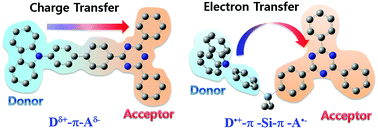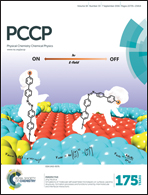The influence of π-conjugation on competitive pathways: charge transfer or electron transfer in new D–π–A and D–π–Si–π–A dyads†
Abstract
In order to elucidate the influence of π-conjugation on photoinduced electron transfer (PET) and intramolecular charge transfer processes, donor–π–acceptor dyads (D–π–A (1) and D–π–Si–π–A (2)) were newly synthesized. In these dyads, carbazole and triazine moieties acted as the electron donor and acceptor, respectively. The fluorescence of dyad 1 red-shifted as the solvent polarity was increased. The electron charge distribution of the excited state of dyad 1 was delocalized in the acceptor moiety, forming the charge transfer Dδ+–π–Aδ− dyad in the excited state. In the excited state of dyad 1, the π-conjugation acted as the linker for charge transfer between the donor and acceptor moieties. A large dipole moment change (Δμ = 45.6 D) between the ground and excited states was determined using the Lippert–Mataga plot. Furthermore, the fluorescence of dyad 1 was observed upon two-photon excitation. In contrast, dyad 2, in which the π-conjugation is disconnected by a Si-atom in the linker, displayed weak dual-emission: a short-wavelength emission at around 350 nm arising from the monomeric species and a long-wavelength one assigned to the emission from an intramolecular exciplex between the donor and acceptor moieties. The weak emission of dyad 2 indicates that the D+˙–π–Si–π–A−˙ species was generated through a PET process in the excited state. The cationic radical species of the carbazole and the anionic radical species of the triazine, which show transient absorption (TA) bands at around 780 and 530 nm, respectively, were characterized using the femtosecond TA method.


 Please wait while we load your content...
Please wait while we load your content...